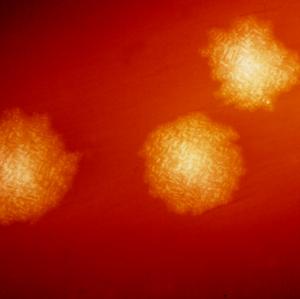Clostridium difficile is a bacterium that causes a life-threatening infection. According to the CDC, it is responsible for about 500,000 infections and 15,000 to 29,000 deaths every year in the United States.
Though the bacterium can infect healthy individuals, it is of particular concern to those who are hospitalized or are taking antibiotics. Antibiotics can wipe out the normal flora of the gut, and C. difficile is happy to fill the vacuum. An infection with this pathogen can cause horrible cramping and 10 to 15 episodes of watery diarrhea per day.
The epidemic has gotten worse in recent years, and a team of researchers led by James Collins and Robert Britton of the Baylor College of Medicine wanted to figure out why. They noticed something very curious when particular events were plotted on a timeline. (See modified figure below.)

In the year 2000, the FDA approved the addition of trehalose, a type of sugar, to food. Europe followed suit the next year. Within just a few years, the C. difficile epidemic exploded. Was that merely a coincidence? Dr. Collins and Dr. Britton believe it is not.
The Trouble with Trehalose
From a nutritional or toxicological perspective, there is nothing wrong with trehalose. It is a disaccharide sugar, molecularly similar to table sugar (sucrose). Our bodies break down and metabolize trehalose just like many other sugars we consume. The reason trehalose wasn't commonly found in our diet until recently was due to its expense. A key technological innovation, however, brought the price down from $700 per kilogram to merely $3. Furthermore, in addition to being cheap, various properties make trehalose quite useful for the food industry.
 The trouble is that some strains of C. difficile like to eat trehalose, too. Two genetically distinct strains of C. difficile, called RT027 and RT078, are causing epidemics all over the world. And they both grow very well in the presence of trehalose. (See figure on right.)
The trouble is that some strains of C. difficile like to eat trehalose, too. Two genetically distinct strains of C. difficile, called RT027 and RT078, are causing epidemics all over the world. And they both grow very well in the presence of trehalose. (See figure on right.)
The left column (DMM) depicts a control condition in which strains of C. difficile are given nutrient-poor food. As expected, the bacteria don't grow well. The middle column (glucose) shows that all strains of C. difficile grow in the presence of this sugar. The right column (trehalose) is the experimental group: This shows that only particular strains of C. difficile (RT027 and RT078) grow in the presence of trehalose.
 Next, the authors wanted to determine if trehalose metabolism could increase the lethality of C. difficile. So, the team infected mice with two different versions of RT027: One was the regular version that could metabolize trehalose, and the other was a genetically altered version that could not. Five days later, only about 40% of the mice that were infected with the regular version of RT027 were alive compared to nearly 80% of mice that were infected with the trehalose-deficient version. (See figure on left.)
Next, the authors wanted to determine if trehalose metabolism could increase the lethality of C. difficile. So, the team infected mice with two different versions of RT027: One was the regular version that could metabolize trehalose, and the other was a genetically altered version that could not. Five days later, only about 40% of the mice that were infected with the regular version of RT027 were alive compared to nearly 80% of mice that were infected with the trehalose-deficient version. (See figure on left.)
Finally, the authors examined intestinal samples from three human volunteers. Two of them had levels of trehalose in their intestine that were detectable by C. difficile RT027, indicating that the normal human diet provides a sufficient amount of trehalose to give these dangerous strains a competitive advantage.
Conclusions
Though there are still many unanswered questions, the implications of this research are potentially huge. At the very least, any person who is suffering from a C. difficile infection should consider eliminating trehalose from his diet for the duration of the infection.
Source: J. Collins, C. Robinson, H. Danhof, C. W. Knetsch, H. C. van Leeuwen, T. D. Lawley, J. M. Auchtung, R. A. Britton. "Dietary trehalose enhances virulence of epidemic Clostridium difficile." Nature. Published online: 3-Jan-2018. DOI: 10.1038/nature25178




